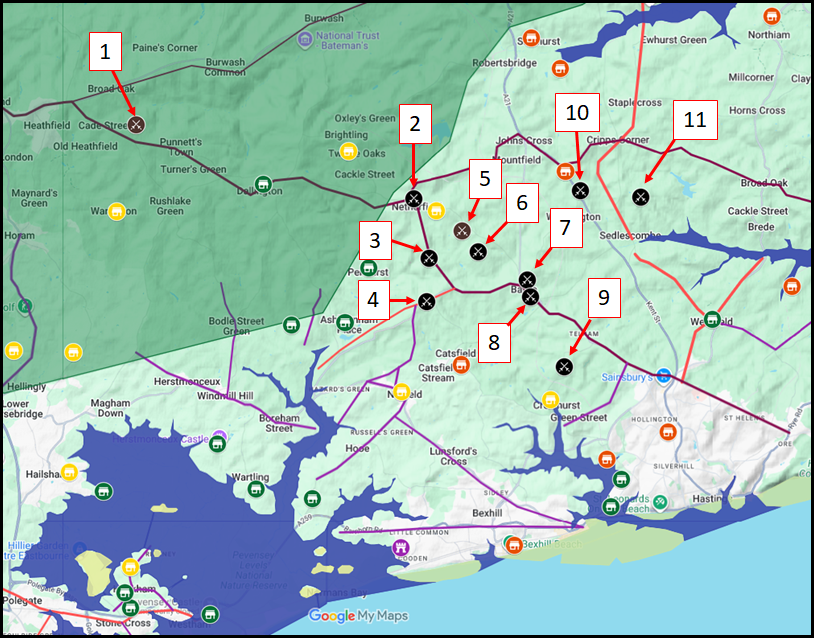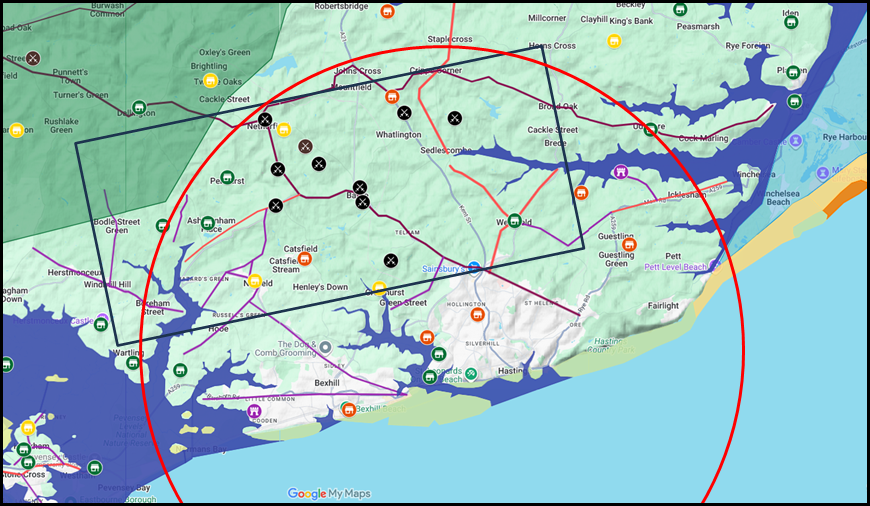|
 | Anglo Saxon History |  | |
| | Battle of Hastings 1066AD - S - The Battlefield Location |
|---|
| | Why are alternate sites continuously being suggested |
|---|
The biggest problem that the story of 'The Battle of Hastings' has is that there is no or very
limited physical evidence for a Battle anywhere in the Hastings area.
At the moment there is only one piece of physical evidence dated to the period that has been found in the area, this can
be found in Battle Museum and is an axe head dated to the period by an arms expert from one of the London Museums. The
axe head can't be carbon dated as it was covered in varnish from the 1950's.
This axe head is the right size for a Battleaxe, however as The Great Forest of Andredsweald - Anglo Saxon
Chronicles was in the area, its possibly an axe used for felling oak trees, as these were a similar size and shape
in this period.
The axe was donated to the Museum in 1953 and the owners lived in an area of Battle called Marley Lane, however there
are no details if this was found there or if it belonged to a relative who lived in the area.
So we have one artifact and no provenance, this is where the alternative sites ideas are derived from.
The 'Time Team' from the Channel 5 TV company came to Battle Abbey in 2003 to discover evidence for the Battle on the
claimed Battlefield, which is on a slope to the South East of the Abbey. You can see this episode on the following link
1066 - The Lost Battlefield | Time Team Classic Special (Full
Episode) , where they found no evidence, but suggested that the Battle may have been fought eastwards towards Battle
Hill on the A2100.
This now has provided a number of sites proposed by various local people who believe the Abbey was built in a convenient
place as it is on the main ridgeway out of Hastings, has fresh water and a nearby quarry for stone.
So I will now bring you the various sites that have been proposed, these are on separate pages on the site as one page
on all the proposed sites would be difficult to navigate through.
I will try to be analytical in my view, but may be a bit biased in my view on one of the sites but will let you know
which one it is.
|
The sites that have been proposed as at Dec 2025
|
|---|

The map above shows the area with the high tides marked in blue, as you can see the area is a peninsular and the way out
on land is via Heathfield or Bodiam. Red villages are those marked as destroyed in Domesday, Yellow are marked as
damaged and the Green ones are those marked as undamaged settlements. The Forest of Andredsweald is shown as a green
shaded area.
| | Website and Book links for the Battlefield sites |
|---|
Please note these are not in any specific order.
- 1. The Hoar Apple Tree
- 2. Netherfield
-
This is suggested by Simon Mansfield and is based on the landscape around the junction of the Battle Road(B2096) and the
Netherfield road at Darvel Down.
- 3. Creep Wood
-
This one is based on a book by Kathleen Richardson - 'The Mystery of Town
Creep', and is predicated on the fact that Town Creep is claimed to be an old Roman fort.
.
- 4. Normanhurst
-
This location has no one person suggesting it, but is based on the belief that Standard Hill at Ninfield was where
William had his flag, and this is the next ridge in the area
.
- 5. Ashes Wood
-
This location is suggested by Kevin Casey in his blog.
- 6. Beech Farm Hill
-
This location was originally suggested by Simon Coleman but he has now rejected this site and '1. The Hoar Apple Tree'
location has superceeded this site
.
- 7. Caldbec Hill
- 8. Battle Abbey
- 9. Crowhurst
- 10. Whatlington
-
This location is proposed by Fred Waghorn, but to be fair it is a location for the last battle of the Saxons at the
Malfosse which is near a proposed hillfort at the White Chapel in Whatlington, this was published in a set of maps in
2010 but is now online at https://1066history.co.uk/home-page.
- 11. Sedlescombe
| | |
|---|
| Chronicle snippets that describe the landscape around the Battle |
|---|
Anglo Saxon Chronicles
Battle of Hastings 1066AD - The Hoar Apple tree -
they met him at the orchard where the hares run
The Bayeux Tapestry
A rough hill is shown but that's all
Battle Abbey Chronicles
- Having arrived at a hill called Hechelande, situated in the direction of Hastings
- Upon the hill where the Abbey now stands, the English supported their king in a compact body
- There lay between the hostile armies a certain dreadful precipice (see our Battle of Hastings 1066AD Observations - Evidence for the
Malfosse)
- The place being marked where the standard of this rash and hostile invasion fell
Master Wace - The Roman de Rou
- till he erected his standard and fixed his gonfanon right where THE ABBEY OF THE BATTLE is now built
- he had the place well examined, and surrounded it by a good fosse, leaving an entrance on each of three sides, which
were ordered to be all well guarded. (Battle of Hastings 1066AD
Observations - Evidence for the Malfosse)
- The duke stood on a hill, where he could best see his men
- Harold knew that the Normans would come and attack him hand to hand : so he had early enclosed the field in which he
placed his men. (Battle of Hastings 1066AD Observations -
Evidence for the Malfosse)
- They had built up a fence before them with their shields, and with ash and other wood ; and had well joined and
wattled in the whole work, so as not to leave even a crevice; and thus they had a barricade in their front, through
which any Nor man who would attack them must first pass.
- Meanwhile the Normans appeared, advancing over the ridge of a rising ground
- Meanwhile, a fresh company came in sight, covering all the plain
- The youths and common herd of the camp, whose business was not to join in the battle, but to take care of the
harness and stores, moved off to wards a rising ground. The priests and the clerks also ascended a hill,
- In the plain was a fosse, which the Normans had now behind them, having passed it in the fight with out regarding
it. But the English charged and drove the Normans before them, till they made them fall back upon this fosse,
overthrowing into it horses and men. (Battle of Hastings 1066AD
Observations - Evidence for the Malfosse)
- the combatants are many, the plain wide
- The English stood firm in their barricades, and shivered the lances, beating them into pieces with their bills and
maces. The Normans drew their swords and hewed down the barricades, (Battle of Hastings 1066AD Observations - Evidence for the
Malfosse)
- The English fell back upon a rising ground, and the Normans followed them across the valley,
- The press was great to cross the bridge, and the river beneath it was deep ; so that the bridge broke under the
throng, and many fell into the water. (Battle of Hastings
1066AD - T - A Bridge collapse in the retreat)
The Carmen of Guy d'Amiens
- Where he advances(Harold) there he lays planks of wood
And by this means makes dry crossings of rivers
- And the woods full of gleaming weapons
Suddenly a company of English emerged from the forest
And the column rushed from wooded cover
Nearby was a wooded hill, neighbouring the valley
Its terrain was rugged and uncultivated
The English as is their custom advancing crowded together
The king ascended the summit that he might wage war in the midst of his army
At the summit of the hill a streaming banner was planted
The Duke below fearing mastery from the height checks the advancing column
And boldly approaches the steep slope
- They gather in tight formation to charge the slope for slaughter
- The sea is behind back by sea is the way to return
- When the duke spies the king above on the steep hill
His hard pressed men are being torn to pieces
- And so carried with him, returned to his seaside camp
Swearing it better Harold was buried promptly on the coast of the port under a heap of stones
-
Therefore just as he had vowed high on a cliff
He ordered the body entombed on the ground at the summit.
That he may remain sentry over sea and strand
Florence of Worcester
Henry of Huntingdon
Orderic Vitalis
- the English troops, assembled from all parts of the neighbourhood, took post at a place which was anciently called
Senlac.(Battle of Hastings 1066AD - Senlac Hill where is it? and
what might Senlac mean?)
- Various were the fortunes which attended their retreat ; some recovering their horses, some on foot, attempted to
escape by the highways ; more sought to save themselves by striking across the country
- for, galloping onward in hot pursuit, they fell unawares, horses and armour, into an ancient trench, overgrown and
concealed by rank grass, and men in their armour and horses rolling over each other, were crushed and smothered. (Battle of Hastings 1066AD Observations - Evidence for the
Malfosse)
| | Times and Timezones |
|---|
To try to get some idea of possible locations we can try to use the sunrise sunset times that cover this area.
You must be aware that sunrise sunset times vary across every location in the world due to latitude
and longitude changes.
Now we can get the modern sunrise/sunset times for Bexhill as this seems to be the probable location of the Norman camp.
So for the 14th October the sunrise/sunset times are 07:19 ->18:07(GMT) this is taken from Time and Date.com
However there is light before sunrise and this was 06:46->18:40(GMT), so there is about 34 minutes before dawn where it
is light.
Orderic Vitalis writes:
So the Battle raged from the third hour and Harold the King was killed in the first assault.(Harold death conflicts
with other Chronicles)
So this could mean from sunrise or twilight, and so the start was sometime around 9.45 to 10.15(GMT) using modern
calculations, however this may have meant it started before the fourth hour of the day.
Let us assume therefore that the possible start of the Battle was between 09:46 to 11:19(GMT), this would mean that the
Normans, allowing 30 minutes to prepare, could have marched at 2.5 mph between 2 and 4 hours from their coastal base,
this equates to somewhere between 5 and 9 miles, but could have been less so probably 2 mph to allow for weapons etc
that would give 4 miles to a maximum of 8 miles.
|
Map showing possible distances from the Normans coastal base
|
|---|

Map of the area showing a box which goes from the coast from 2.5 miles up to 8 miles inland.
As you can see this area covers the majority of the suggested sites.
|
|
|
|
|
|
| |
|
|
Local Interest
Just click an image |
|
|
|
|
|
|
|
|
|
|
|
|
| |
|
|